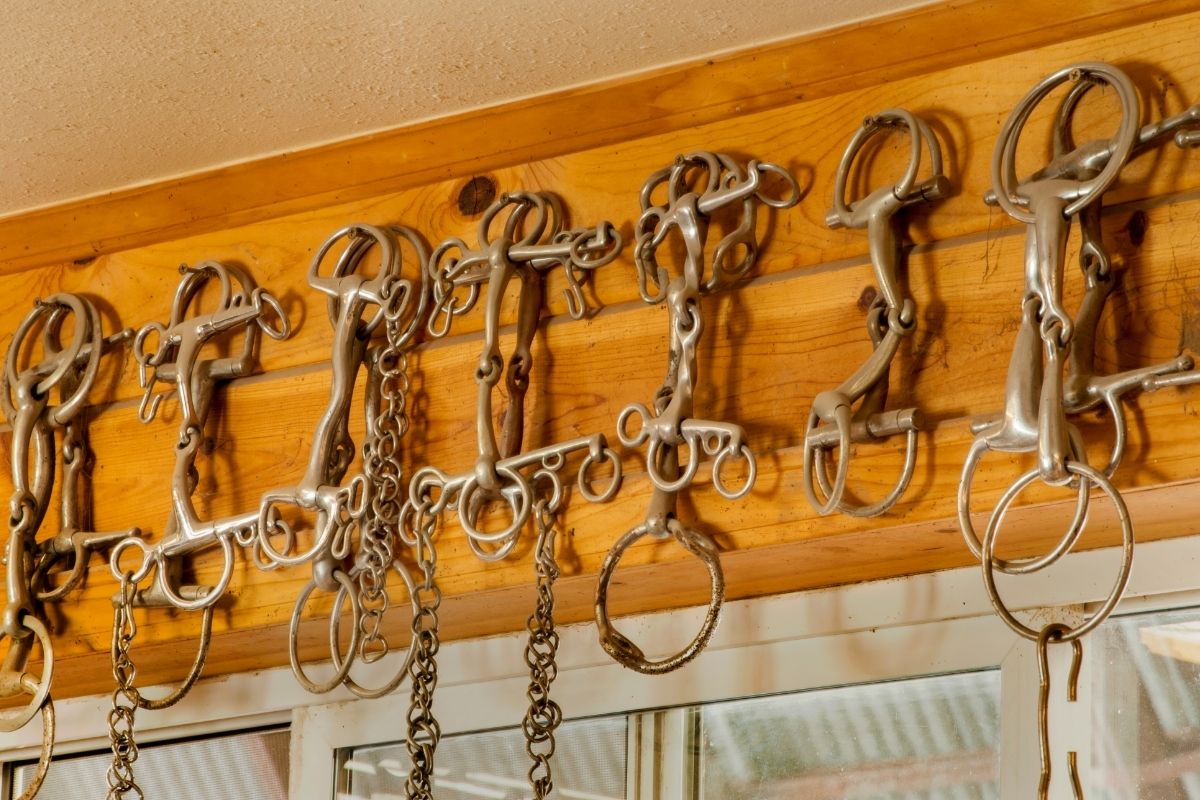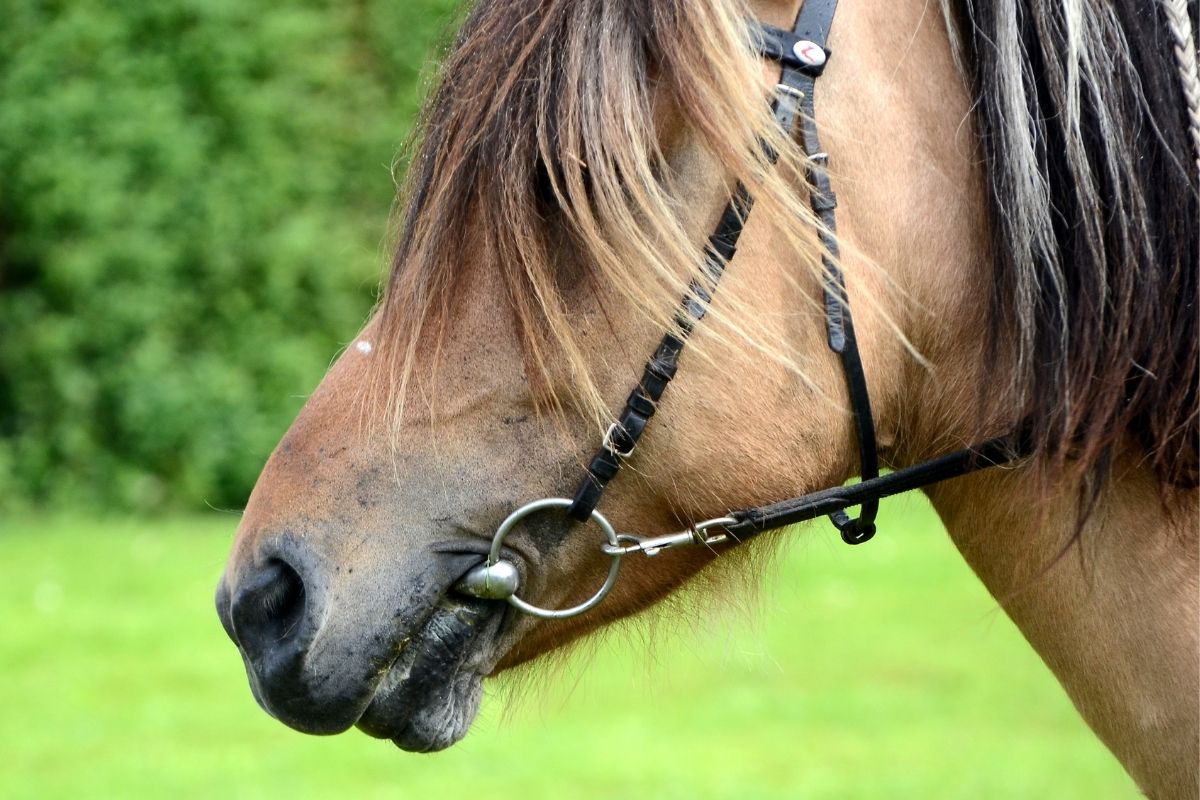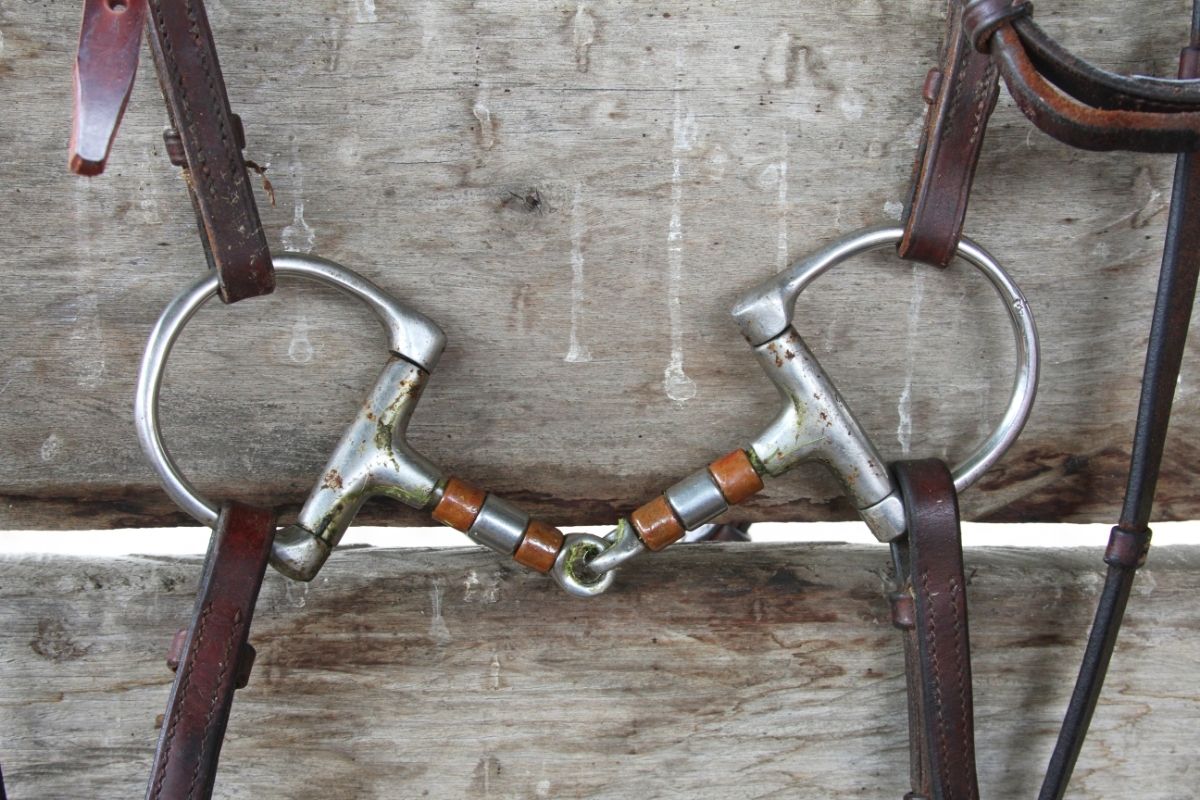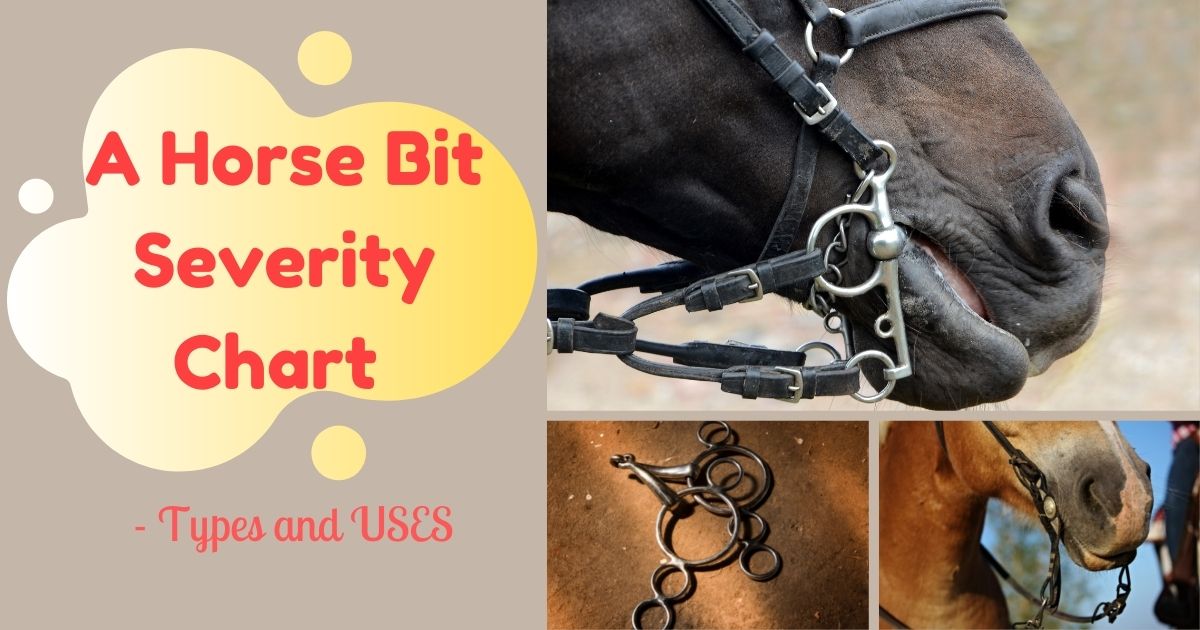There are many assumptions about horse bits. Some equestrians advise on using bits, while others don’t. Since they come in different options, a horse bit severity chart will help you select the one that fits your four-legged friend.
Horse bits play an important part in the horse and horse rider because they enhance communication. When you fit a bit in a horse’s mouth, it gets into contact with the rider’s hand and then to the horse’s brain.
The way one horse will respond is not how another one will respond. If this happens, you will end up looking for a better bit. Since finding the perfect bit for your equine friend is a lot of trial and error, a horse bit severity chart will save you a mil.
Therefore, check out detailed information about a horse bit severity chart. Additionally, you will learn about different types of bits and their uses.
Therefore, ride on and explore more!

What is a Horse Bit?
What is a horse bit? This is a tough question that many people fail to understand. A horse bit is simply a type of equipment put in a horse’s mouth to help control it. The bit is attached to a harness to hold on the horse’s head.
Furthermore, the rider holds it and allows them to cue and control the horse. The mouthpiece enters the horse’s mouth and is either rubber, metal, or plastic. Since horse bits come in many options, you need to choose the right one. On top of that, you need to be careful not to hurt the horse’s mouth.
Now that you know what horse bits entail, how do they work? Let’s find out!
How do Horse Bits Work?
Horse bits play an important part in horses since they help control the horse, enhancing accessible communication. The bit comprises rings, shanks, mullen, and cheek pads. The mullen is the region with no teeth; between molars and incisors extends across the mouth and rests on the bars.
The bit is placed on the horse’s head with some components to enhance proper adjustment while controlling the horse. The bridle, reins, and bit give control of the horse’s head to the rider. While the rein forces control signal and weight distribution from the rider’s leg, the bit applies pressure to the mouth. Therefore, using soft bits for horses will reduce stress.
How to Choose the Right Bit for Your Horse
There are many types of horse bits, and choosing the right one can be a minefield. This is because they contain distinct features suited for different horses. If you are unsure of where to start, check out this guide to help you choose the right bit for your horse.
The Horse’s Mouth
Investing in your horse’s mouth is a critical factor to consider. Many horse riders fail to consider the mouth an essential part of the horse’s body. Horses need a quality bit to protect the mouth and last for a long time.
Understand What You Need
Before going further, understand what you need. This goes down to the behavior of your horse and the solution for that problem. Certain bits can help you tune up your horse when it’s having a problem. If you are unsure, seek advice from your instructor or a bitting expert.
The Type of Material
Another aspect is the type of material. Horse bits contain different materials such as metal, plastic, or rubber. These materials will warm up quickly and will promote salivation. A good quality horse mouth bit will increase saliva and promote acceptance.
The Height of Your Horse Bit
Apart from good quality material, the bit’s height is also vital. When gauging the size of your horse, give it enough wrinkles. Ensure that the neck and face are natural and the mouth is relaxed. To reduce more wrinkles, touch each corner of the mouth slightly upwards.
Your Discipline
The discipline that you ride is crucial in choosing the right bit. There are many types of bits, and some are used for all purposes. For instance, what’s appropriate for a Reiner probably won’t work for a Saddlebred. This is because they have different movements; low versus high head carriage.
Don’t Rely on a Bit
Lastly, you need to understand that changing a horse bit will not change your horse’s ability. Bits don’t change behavior but will work if you facilitate the process by helping your horse. You need to listen to your horse and work on finding a bit that makes it work on them. Focusing on comfort will give you disappointments.
Importance of a Horse Bit
Finding the best bit for a horse is vital for the following reasons:
Enhances Communication
Horse bits play an important role in the lives of horses and their riders. It allows the rider to connect the harness through the veins. When this happens, communication is sent quickly to the horse leading to a quick response. Also, you can achieve communication if your horse accepts the bit.
Control
Controlling a horse is not as easy as many people think. It requires cooperation between the horse and the owner. The bit, bridle, and reins work together to control the horse’s head and send signals to the rider.
Horse Bits in Order of Harshness
There are many types of horse bits. Each horse bit is designed with different specifications to suit different breeds. The bits are classified into either gentle, intermediate, or advanced. If you are searching for a horse bit, check out the following horse bits in order of harshness. From this list, you will get the one suitable for your horse.
Colt Bit
Colts are low-leverage bits that offer a loose side pull with large rings for lighter contact. This bit resembles a Mullen’s mouth but exhibits short shanks, enhancing a mild curb action. When at rest, the grazing bit’s mouthpiece portrays a slight curve to reduce pressure on the tongue.
What You Should Know About the Colt Bit
- Also known as a colt-starting bit.
- Applies mild and evenly-distributed pressure across tongue and jaw.
- Has severe effects when used roughly.
Best Suited For
- Western disciplines.
- Trail rides.
- Green horses.
- Beginner riders.
Cathedral, Spoon, Spade, and Correction Bits
These curb bits feature a mouthpiece with a large, narrow port in the middle. At some point, the port’s top may flatten out to a small or significant degree.
What You Should Know about Cathedral, Spoon, Spade, and Correction Bits
- They have a roller under the port to help the horse relax its jaw.
- The horse should pick up and hold the bit in the mouth.
- Mouthpieces are either solid or swiveled.
- Larger ports are more severe.
Best Suited For
- Advanced riders and horses.
- Western disciplines.
Gag Bits
Closing the list of the common types of horse bits are the Gag bits. Gag bits have a similar appearance to a snaffle bit; a mouthpiece and a ring on either side. Also, they are somehow similar to the pelham and double bridle bit, but the gag bit has no curb strap.
However, each ring has two holes on top and bottom for gaga cheek pieces to feed through. These bits are mainly used in horses that need training or the ones that are strong pullers. They also help elevate a horse that is heavy on its front head.
Occasionally, gag bits are seen in a sliding mouthpiece on a shanked-in Western-style competition. These bits might look slightly different, but they all rely on a significant amount of leverage.
What You Should Know About Gag Bits
- Placing the reins further away from the mouthpiece to obtain stronger leverage.
Best Suited For
- Advanced horses and riders
- Horses that are poor in stopping
Kimberwick
A Kimberwick is a curb bit with two slots for reins and different mouthpieces. It often features an unjointed bar with a port in the middle.
What You Should Know About Kimberwick Bit
- A low port is milder than a high port.
- Use a lower rein slot for more leverage and an upper rein slot for more direct action.
- Horses love it because it is comfortable and offers adequate space for the tongue.
- It should be used with a curb chain.
- It is not used in Western shows.
Best Suited For
- Horses that are poor at stopping.
- Equines that like to lift their heads.
- Horses with or under training.
- Riders with independent hands.
Loose Ring French Link Snaffle
A French link is a type of snaffle with two joints in the center of the mouthpiece, connected via a lozenge. Generally, these bits are the most commonly used for riding horses. They consist of a bit mouthpiece and a ring on either side which acts with direct pressure.
These bits enhance accessible communication, thus suitable for beginners and training young horse riders. Among the category of snaffles, it is the mildest snaffle bit. It works best to produce a gentle action when paired with an O-ring or loose ring cheekpiece.
What You Should Know about the Loose Ring French Link Snaffle
- Lozenge made of copper stimulates salivation and a softer jaw.
- Applies mild pressure to the jaw and the roof of the mouth.
- Pair it with a D-ring or eggbutt cheekpiece if you want proper communication.
Best Suited For
- Horses of all levels.
- All disciplines.
- Riders of all levels.
Mullen Mouth With O-Rings
Mullen mouth bit is a gentle horse bit that exhibits a smooth, flat mouthpiece with no joints and twists. However, it can be slightly curved. The good thing about this bit is that it provides the mildest action and can be combined with any cheekpiece.
What You Should Know About Mullen Mouth With O-rings
- The mouthpiece should not be thick for your horse’s mouth.
- The bit applies mild and evenly-distributed pressure to the jaw and tongue.
Best Suited For
- Beginner riders.
- Trail rides.
- Green horses.
Ported Curb Bit
Curb bits are standard pieces of gear for western riders. This bit is used for riding horses that use lever action. When the rains are pulled, curves work on three points of the horse’s head by applying pressure on the horse’s mouth, poll, and chin.
It contains a curb strap that creates pressure and prevents the bit from rotating too far around your horse’s mouth. Some contain a lip strap to prevent the horse from chewing the shank.
In this category, the ported curb bit for horses is another type of intermediate horse bit. The all-purpose bit resembles a colt bit but has a port in the mouthpiece.
What You Should Know About Ported Curb Bit
- Longer shanks make this bit severe.
- Shanks should be curved.
- A low port is considered milder than a high port.
- Some may include rollers on the port to help the horse soften its jaw.
Best Suited For
- Beginner riders who have learned not to hang onto the horse’s mouth.
- Green horses are already used to a colt bit.
- Western horses.
Pelham Bits
A pelham bit is another common type of horse bit used when riding a horse. It contains snaffle and curb bit tools and has double reins. It has a mouthpiece, shanks with lever arms, purchase, curb chain, and a ring for rein attachment at the bottom of the shank.
Like a snaffle bit, it also has a ring on either side of the mouthpiece. It is used as a double bridle in the English riding disciplines. This is specifically when it is desirable to have double reins but not two bits. Also, it is used in English and western disciplines to transition a horse from a snaffle bit to a curb bit.
What You Should Know About Pelhalms
- They are used in hunter competitions but rarely allowed in dressage.
- They can be used with two sets of reins, as only a snaffle or a curb bit.
- If you use pelhams as curb bits, they’ll require curb chains.
- Longer shanks cause severe curb action.
- Suitable for any type of snaffle mouthpiece.
Best Suited For
- Advanced riders and horses.
- Horses that lean on the forehand.
Single Joint Snaffles
A single joint snaffle falls in the category of intermediate horse bits. It can apply significant pressure to the jaw thanks to its nutcracker action. Therefore, it’s unsuitable for heavy-handed riders or horses who don’t stop well.
What You Should Know About Single Joint Snaffles
- Available in many different thick and thin widths, thin is considered more severe.
- You can pair it with any kind of cheekpiece, including shanks.
- Applies pressure to jaw and bars of the mouth, as well as tongue and roof of the mouth.
Best Suited For
- Riders with light hands.
- Horses with basic training.
- Any discipline.
Tom Thumb Bit
If you want a leverage bit with straight shanks, opt for the Tom Thumb. This bit has shanks that do not curve backward. This makes the reign movement go to the bit thus severe. Another interesting thing about the curved shanks is that they warn the horse, responding quickly before further action.
What You Should Know about Tom Thumb Bit
- Mostly have a single joint but can have any type of mouthpiece.
- Has longer the shanks when the bit is severe.
Best Suited For
- Strong horses.
- Pro riders who can communicate with their seat and voice before using the reins.
Waterford Snaffles
Waterford mouthpieces feature a “ball and chain” design with multiple joints. It also Pairs with loose rings for the mildest action.
What You Should Know About Waterford Snaffles
- Distributes pressure across the tongue and jaw.
- Lacks nutcracker action.
- It can be severe if riders “saws” with their hands.
Best Suited For
- Horses who lean on the bit.
- Horses who cross their jaw to grab the bit.
- Riders with soft, independent hands.
Waterford Snaffles
Waterford mouthpieces feature a “ball and chain” design with multiple joints. It also Pairs with loose rings for the mildest action.
What You Should Know About Waterford Snaffles
- Distributes pressure across the tongue and jaw.
- Lacks nutcracker action.
- It can be severe if the rider “saws” with their hands.
Best Suited For
- Horses who lean on the bit.
- Horses who cross their jaws to grab the bit.
- Riders with soft, independent hands.

How to Measure the Size of a Bit
Measuring your horse’s bit does not involve calculating with your eyes. You need the correct measurements to get the right fit. You can measure the horse’s mouth by taking a piece of string and tying a knot at the end.
Put the string on the mouth as they are located outside the mouth. Mark the string with a pen where it meets outside the lips. In the end, you will get the size from a distance between the mark and the knot.
A Horse Bit Severity Chart
Horse bits are important in horses’ lives. They not only aid in communicating but also enhance control. A good horse bit is outstanding and unique. There are different types of bits in the market. Each bit is designed differently but functions the same way.
Also, they exist and are ranked from mild to more controlled. With that in mind, here is a horse bit severity chart to help you find the right fit for your horse. As a rider, always embrace kindness on your horse. Leave bits with more control experienced riders since they know how to use them.
A Horse Bit Severity Chart
| Snaffle Mouth Pieces With No Leverage (Milder) | Best for |
| Mullen Mouth | Beginner riders |
| French link | Beginner riders |
| Single joint | Beginner riders |
| Waterford | Beginner riders |
| Single twist | Beginner Riders |
| Double twist | Beginner riders |
| Snaffle Cheekpieces | |
| Loose ring | Beginner riders |
| Eggbutt | Beginner riders |
| Hanging cheek | Beginner riders |
| D-ring | Beginner riders |
| Full cheek | Beginner riders |
| Ported Mouth Pieces | |
| Low port<High port | Experienced riders |
| Wide port<Narrow port | Experienced riders |
| Shanks | |
| Short<Long | Experienced riders |
| Angled<Straight | Experienced riders |
FAQs on Horse Bits
Q: What is the best bit for equine trail riding?
A: The best horse bit for trail riding is the gentle bit. This is because it provides a comfortable ride. However, you can opt for a stronger bit if your horse needs to be controlled. Read our article and find out the best horse breeds for trail riding.
Q: What is the best horse bit for exercising control?
A: The perfect horse bit for exercising control depends on the issue at hand.
If you have a horse that does not stop, for instance, you can switch to a curb or snaffle bit. Furthermore, you can apply a different training method to make things easier.
Q: What is the best bit for beginner horse riders?
A: If you are a beginner, try a gentle bit because it will give the rider enough control and ample time to understand the horse. For instance, you can try a Mullen mouth snaffle because it allows the horse to listen to the rider’s instructions.
Q: What is the best bet for a horse that pulls?
A: The best bit for horses that pulls is a bit that is not too high or low in the horse’s mouth. Generally use a bit with loose rings such as the Waterford.
Q: What is the best bit for a green horse?
A: The best bet for a green horse should be simple to avoid sending complex signals. A perfect bit for such horses is a Mullen mouth snaffle. With this bit, your horse will learn about feeling pressure on the tongue and corners of the mouth. When they are good enough, introduce other types of pressure and bits.

Bit by Bit
Bits are essential in a horse’s life. They help in controlling the horse, creating accessible communication. As a horse owner, you must be overwhelmed by many options out there, and you will often find yourself investing in the wrong bits.
This is because you lack enough knowledge about the best bit for you and your horse unless you try a few. If so, don’t panic; even pro horsemen and women get confused and lack enough information about different types of bits.
You can use a horse bit severity chart to ask your trainer or a professional for help. They have various bits and will help you try a few and fit them properly. Happy ride!
